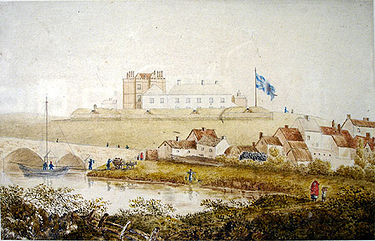
Charlemont Fort
Encyclopedia

Garrison
Garrison is the collective term for a body of troops stationed in a particular location, originally to guard it, but now often simply using it as a home base....
built in Charlemont
Charlemont
Charlemont is a small village in County Armagh, Northern Ireland. It had a population of 150 people in the 2001 Census. It is situated within the Armagh City and District Council area...
, County Armagh
County Armagh
-History:Ancient Armagh was the territory of the Ulaid before the fourth century AD. It was ruled by the Red Branch, whose capital was Emain Macha near Armagh. The site, and subsequently the city, were named after the goddess Macha...
in 1602 by Lord Mountjoy
Charles Blount, 1st Earl of Devonshire
Charles Blount , 8th Baron Mountjoy and 1st Earl of Devonshire was an English nobleman and soldier who served as Lord Deputy of Ireland under Queen Elizabeth I, then as Lord Lieutenant under King James I.-Early life:...
. It was destroyed in 1920 by fire and the only building remaining today is the gatehouse. The name Charlemont came from Charles Blount's Christian name. It was situated on the Armagh bank of the River Blackwater
River Blackwater, Northern Ireland
The River Blackwater is a river in County Armagh and County Tyrone, Northern Ireland, as well as County Monaghan and County Cavan in Republic of Ireland, which has its source to the north of Fivemiletown, County Tyrone...
, it was armed with 150 men under the command of Sir Toby Caulfield
Viscount Charlemont
Viscount Charlemont is a title in the Peerage of Ireland. It was created in 1665 for William Caulfeild, 5th Baron Charlemont. The Caulfeild family descends from Sir Toby Caufeild, originally of Oxfordshire, England. He was a noted soldier and also represented Armagh in the Irish House of Commons...
, whose descendants took the name Charlemont from the place.
The Stronghold of Charlemont proved to be of great strategic importance in the Irish Confederate Wars
Irish Confederate Wars
This article is concerned with the military history of Ireland from 1641-53. For the political context of this conflict, see Confederate Ireland....
in the 1640s, as it was one of only a handful of modern fortresses to be found in Ireland at that time. It was captured by the forces of Felim O'Neill
Felim O'Neill of Kinard
Sir Felim O'Neill of Kinard , also called Phelim MacShane O'Neill or Féilim Ó Néill , was an Irish nobleman who led the Irish Rebellion of 1641 in Ulster which began on 22 October 1641. He was a member of the Irish Catholic Confederation during the Wars of the Three Kingdoms, where he fought under...
in 1641 and the Ulster army of the Irish Confederates managed to hold onto the fort throughout the 1640s. It was eventually captured by Charles Coote after he had been reinforced by New Model Army
New Model Army
The New Model Army of England was formed in 1645 by the Parliamentarians in the English Civil War, and was disbanded in 1660 after the Restoration...
soldiers in late 1650, but hundreds of Cootes soldiers were killed in the effort.
The governor's house within the fort, which ceased to be a public building in the mid 19th Century, later became the home of the Charlemonts.
Destruction
On 30 July, 1920 a group of around forty armed men seized the fort, which was being occupied by a caretaker, and burned it downArson
Arson is the crime of intentionally or maliciously setting fire to structures or wildland areas. It may be distinguished from other causes such as spontaneous combustion and natural wildfires...
. The ruins were sold in 1921 to a masonry contractor. In 1920 the family also lost their great house Roxborough Castle
Roxborough Castle
Roxborough Castle was a castle in Moy, County Tyrone, Northern Ireland originally built in 1738. It was the seat of the Earls of Charlemont, along with Charlemont Fort, and was burned out by a gang of Irish republicans in 1922....
, Dungannon
Dungannon
Dungannon is a medium-sized town in County Tyrone, Northern Ireland. It is the third-largest town in the county and a population of 11,139 people was recorded in the 2001 Census. In August 2006, Dungannon won Ulster In Bloom's Best Kept Town Award for the fifth time...
County Tyrone
County Tyrone
Historically Tyrone stretched as far north as Lough Foyle, and comprised part of modern day County Londonderry east of the River Foyle. The majority of County Londonderry was carved out of Tyrone between 1610-1620 when that land went to the Guilds of London to set up profit making schemes based on...
to the same fate.

